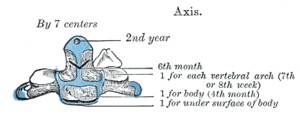- Ossification of axis
-
The axis is ossified from five primary and two secondary centers.
The body and vertebral arch are ossified in the same manner as the corresponding parts in the other vertebrae, viz., one center for the body, and two for the vertebral arch.
The centers for the arch appear about the seventh or eighth week of fetal life, while the centers for the body appear in about the fourth or fifth month.
The dens or odontoid process consists originally of a continuation upward of the cartilaginous mass, in which the lower part of the body is formed.
About the sixth month of fetal life, two centers make their appearance in the base of this process: they are placed laterally, and join before birth to form a conical bilobed mass deeply cleft above; the interval between the sides of the cleft and the summit of the process is formed by a wedge-shaped piece of cartilage.
The base of the process is separated from the body by a cartilaginous disk, which gradually becomes ossified at its circumference, but remains cartilaginous in its center until advanced age.
In this cartilage, rudiments of the lower epiphysial lamella of the atlas and the upper epiphysial lamella of the axis may sometimes be found.
The apex of the odontoid process has a separate center which appears in the second and joins about the twelfth year; this is the upper epiphysial lamella of the atlas.
In addition to these there is a secondary center for a thin epiphysial plate on the under surface of the body of the bone.
This article was originally based on an entry from a public domain edition of Gray's Anatomy. As such, some of the information contained within it may be outdated.
Categories:- Skeletal system
Wikimedia Foundation. 2010.

